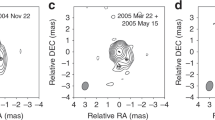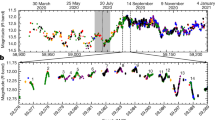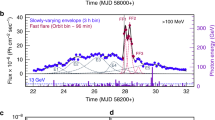Abstract
Supermassive black holes at the centre of active galactic nuclei power some of the most luminous objects in the Universe. Typically, very-long-baseline interferometric observations of blazars have revealed only funnel-like morphologies with little information on the internal structure of the ejected plasma or have lacked the dynamic range to reconstruct the extended jet emission. Here we present microarcsecond-scale angular resolution images of the blazar 3C 279 obtained at 22 GHz with the space very-long-baseline interferometry mission RadioAstron, which allowed us to resolve the jet transversely and reveal several filaments produced by plasma instabilities in a kinetically dominated flow. The polarimetric properties derived from our high-angular-resolution and broad-dynamic-range images are consistent with the presence of a helical magnetic field threaded to the jet. We infer a clockwise rotation as seen in the direction of flow motion with an intrinsic helix pitch angle of ~45° and a Lorentz factor of ~13 at the time of observation. We also propose a model to explain blazar jet radio variability in which emission features travelling down the jet may manifest as a result of differential Doppler boosting within the filaments, as opposed to the standard shock-in-jet model. Characterizing such variability is particularly important given the relevance of blazar physics from cosmic particle acceleration to standard candles in cosmology.
This is a preview of subscription content, access via your institution
Access options
Access Nature and 54 other Nature Portfolio journals
Get Nature+, our best-value online-access subscription
$29.99 / 30 days
cancel any time
Subscribe to this journal
Receive 12 digital issues and online access to articles
$119.00 per year
only $9.92 per issue
Buy this article
- Purchase on Springer Link
- Instant access to full article PDF
Prices may be subject to local taxes which are calculated during checkout



Similar content being viewed by others
Data availability
The pre-processed dataset used for imaging is available via Github at https://github.com/aefez/radioastron-3c279-2014.
Code availability
The software packages used to calibrate, image and analyse the data are available at the following websites: AIPS, http://www.aips.nrao.edu/index.shtml; ParselTongue (https://www.jive.eu/jivewiki/doku.php?id=parseltongue:parseltongue), DIFMAP (https://science.nrao.edu/facilities/vlba/docs/manuals/oss2013a/post-processing-software/difmap), SMILI (https://github.com/astrosmili/smili), eht-imaging (https://github.com/achael/eht-imaging) and lmfit (https://lmfit.github.io/lmfit-py/).
References
Kardashev, N. S. et al. ‘RadioAstron’—a telescope with a size of 300 000 km: main parameters and first observational results. Astron. Rep. 57, 153–194 (2013).
Kim, J.-Y. et al. Event Horizon Telescope imaging of the archetypal blazar 3C 279 at an extreme 20 microarcsecond resolution. Astron. Astrophys. 640, A69 (2020).
Kovalev, Y. et al. Detection statistics of the RadioAstron AGN survey. Adv. Space Res. 65, 705–711 (2020).
Chael, A. A. et al. High-resolution linear polarimetric imaging for the Event Horizon Telescope. Astrophys. J. 829, 11 (2016).
Chael, A. A. et al. Interferometric imaging directly with closure phases and closure amplitudes. Astrophys. J. 857, 23 (2018).
Event Horizon Telescope Collaboration et al. First M87 Event Horizon Telescope results. IV. Imaging the central supermassive black hole. Astrophys. J. Lett. 875, L4 (2019).
Jorstad, S. G. et al. Polarimetric observations of 15 active galactic nuclei at high frequencies: jet kinematics from bimonthly monitoring with the Very Long Baseline Array. Astron. J. 130, 1418–1465 (2005).
Lister, M. L. et al. MOJAVE: monitoring of jets in active galactic nuclei with VLBA experiments. V. Multi-epoch VLBA images. Astron. J. 137, 3718–3729 (2009).
Event Horizon Telescope Collaboration et al. First M87 Event Horizon Telescope results. II. Array and instrumentation. Astrophys. J. Lett. 875, L2 (2019).
Pushkarev, A. B. et al. MOJAVE: monitoring of jets in active galactic nuclei with VLBA experiments. IX. Nuclear opacity. Astron. Astrophys. 545, A113 (2012).
Jorstad, S. G. et al. Kinematics of parsec-scale jets of gamma-ray blazars at 43 GHz within the VLBA-BU-BLAZAR program. Astrophys. J. 846, 98 (2017).
Bloom, S. D., Fromm, C. M. & Ros, E. The accelerating jet of 3C 279. Astron. J. 145, 12 (2013).
Weaver, Z. R. et al. Kinematics of parsec-scale jets of gamma-ray blazars at 43 GHz during 10 yr of the VLBA-BU-BLAZAR program. Astrophys. J. Suppl. Ser. 260, 12 (2022).
Marscher, A. P. & Gear, W. K. Models for high-frequency radio outbursts in extragalactic sources, with application to the early 1983 millimeter-to-infrared flare of 3C 273. Astrophys. J. 298, 114–127 (1985).
Hardee, P. E. On three-dimensional structures in relativistic hydrodynamic jets. Astrophys. J. 533, 176–193 (2000).
Vega-García, L., Perucho, M. & Lobanov, A. P. Derivation of the physical parameters of the jet in S5 0836+710 from stability analysis. Astron. Astrophys. 627, A79 (2019).
Hayashida, M. et al. Rapid variability of blazar 3C 279 during flaring states in 2013-2014 with joint Fermi-LAT, NuSTAR, Swift, and ground-based multiwavelength observations. Astrophys. J. 807, 79 (2015).
Raiteri, C. M. et al. Blazar spectral variability as explained by a twisted inhomogeneous jet. Nature 552, 374–377 (2017).
Shukla, A. & Mannheim, K. Gamma-ray flares from relativistic magnetic reconnection in the jet of the quasar 3C 279. Nat. Commun. 11, 4176 (2020).
Gabuzda, D. C., Murray, É. & Cronin, P. Helical magnetic fields associated with the relativistic jets of four BL Lac objects. Mon. Not. R. Astron. Soc. 351, L89–L93 (2004).
Broderick, A. E. & McKinney, J. C. Parsec-scale Faraday rotation measures from general relativistic magnetohydrodynamic simulations of active galactic nucleus jets. Astrophys. J. 725, 750–773 (2010).
Pasetto, A. et al. Reading M87’s dna: a double helix revealing a large-scale helical magnetic field. Astrophys. J. Lett. 923, L5 (2021).
Aloy, M.-A., Gómez, J.-L., Ibáñez, J.-M., Martí, J.-M. & Müller, E. Radio emission from three-dimensional relativistic hydrodynamic jets: observational evidence of jet stratification. Astrophys. J. Lett. 528, L85–L88 (2000).
Fuentes, A., Gómez, J. L., Martí, J. M. & Perucho, M. Total and linearly polarized synchrotron emission from overpressured magnetized relativistic jets. Astrophys. J. 860, 121 (2018).
Moya-Torregrosa, I., Fuentes, A., Martí, J. M., Gómez, J. L. & Perucho, M. Magnetized relativistic jets and helical magnetic fields. I. Dynamics. Astron. Astrophys. 650, A60 (2021).
Fuentes, A., Torregrosa, I., Martí, J. M., Gómez, J. L. & Perucho, M. Magnetized relativistic jets and helical magnetic fields. II. Radiation. Astron. Astrophys. 650, A61 (2021).
Lobanov, A. P. & Zensus, J. A. A cosmic double helix in the archetypical quasar 3C273. Science 294, 128–131 (2001).
Perucho, M., Kovalev, Y. Y., Lobanov, A. P., Hardee, P. E. & Agudo, I. Anatomy of helical extragalactic jets: the case of S5 0836+710. Astrophys. J. 749, 55 (2012).
Bruni, G. et al. RadioAstron reveals a spine-sheath jet structure in 3C 273. Astron. Astrophys. 654, A27 (2021).
Gómez, J. L. et al. Probing the innermost regions of AGN Jets and their magnetic fields with RadioAstron. V. Space and ground millimeter-VLBI imaging of OJ 287. Astrophys. J. 924, 122 (2022).
Bruni, G. et al. The RadioAstron dedicated DiFX dstribution. Galaxies 4, 55 (2016).
Greisen, E. W. in Information Handling in Astronomy—Historical Vistas Astrophysics and Space Science Library Vol. 285 (ed. Heck, A.) 109–125 (Springer, 2003).
Kettenis, M., van Langevelde, H. J., Reynolds, C. & Cotton, B. ParselTongue: AIPS talking Python. In Astronomical Data Analysis Software and Systems XV Conference Series Vol. 351 (eds Gabriel, C. et al.) 497–500 (Astronomical Society of the Pacific, 2006).
Akiyama, K. et al. Superresolution full-polarimetric imaging for radio interferometry with sparse modeling. Astron. J. 153, 159 (2017).
Akiyama, K. et al. Imaging the Schwarzschild-radius-scale structure of M87 with the Event Horizon Telescope using sparse modeling. Astrophys. J. 838, 1 (2017).
Cho, I. et al. A comparative study of amplitude calibrations for the East Asia VLBI Network: a priori and template spectrum methods. Publ. Astron. Soc. Jpn 69, 87 (2017).
Narayan, R. & Nityananda, R. Maximum entropy image restoration in astronomy. Ann. Rev. Astron. Astrophys. 24, 127–170 (1986).
Högbom, J. A. Aperture synthesis with a non-regular distribution of interferometer baselines. Astron. Astrophys. Suppl. Ser. 15, 417–426 (1974).
Shepherd, M. C. Difmap: an interactive program for synthesis imaging. In Astronomical Data Analysis Software and Systems VI Conference Series Vol. 125 (eds Hunt, G. & Payne, H.) 77–84 (Astronomical Society of the Pacific, 1997).
Event Horizon Telescope Collaboration et al. First Sagittarius A* Event Horizon Telescope results. III. Imaging of the galactic center supermassive black hole. Astrophys. J. Lett. 930, L14 (2022).
Event Horizon Telescope Collaboration et al. First M87 Event Horizon Telescope results. VII. Polarization of the ring. Astrophys. J. Lett. 910, L12 (2021).
Holdaway, M. A. & Wardle, J. F. C. Maximum entropy imaging of polarization in very long baseline interferometry. In Digital Image Synthesis and Inverse Optics Conference Series Vol. 1351 (eds Gmitro, A. F. et al.) 714–724 (SPIE, 1990).
Hovatta, T. et al. MOJAVE: monitoring of jets in active galactic nuclei with VLBA experiments. VIII. Faraday rotation in parsec-scale AGN jets. Astron. J. 144, 105 (2012).
Park, J. et al. Revealing the nature of blazar radio cores through multifrequency polarization observations with the Korean VLBI Network. Astrophys. J. 860, 112 (2018).
Newville, M. et al. lmfit/lmfit-py: 1.0.3. Zenodo https://doi.org/10.5281/zenodo.5570790 (2021).
Marziani, P., Sulentic, J. W., Dultzin-Hacyan, D., Calvani, M. & Moles, M. Comparative analysis of the high- and low-ionization lines in the broad-line region of active galactic nuclei. Astrophys. J. Suppl. Ser. 104, 37–70 (1996).
Planck Collaboration et al. Planck 2015 results. XIII. Cosmological parameters. Astron. Astrophys. 594, A13 (2016).
Nilsson, K., Pursimo, T., Villforth, C., Lindfors, E. & Takalo, L. O. The host galaxy of 3C 279. Astron. Astrophys. 505, 601–604 (2009).
Bardeen, J. M. & Petterson, J. A. The lense-thirring effect and accretion disks around Kerr black holes. Astrophys. J. Lett. 195, L65–L67 (1975).
Morgan, C. W., Kochanek, C. S., Morgan, N. D. & Falco, E. E. The quasar accretion disk size-black hole mass relation. Astrophys. J. 712, 1129–1136 (2010).
Mizuno, Y., Lyubarsky, Y., Nishikawa, K.-I. & Hardee, P. E. Three-dimensional relativistic magnetohydrodynamic simulations of current-driven instability. III. Rotating relativistic jets. Astrophys. J. 757, 16 (2012).
Perucho, M. Dissipative processes and their role in the evolution of radio galaxies. Galaxies 7, 70 (2019).
Hardee, P. E. Spatial stability of jets: the nonaxisymmetric fundamental and reflection modes. Astrophys. J. 313, 607 (1987).
Rybicki, G. B. & Lightman, A. P. Radiative Processes in Astrophysics (Wiley, 1979).
Lyutikov, M., Pariev, V. I. & Gabuzda, D. C. Polarization and structure of relativistic parsec-scale AGN jets. Mon. Not. R. Astron. Soc. 360, 869–891 (2005).
Acknowledgements
We thank L. Hermosa for useful comments on the manuscript. The work at the IAA-CSIC was supported in part by the Spanish Ministerio de Economía y Competitividad (grant numbers AYA2016-80889-P and PID2019-108995GB-C21), the Consejería de Economía, Conocimiento, Empresas y Universidad of the Junta de Andalucía (grant number P18-FR-1769), the Consejo Superior de Investigaciones Científicas (grant number 2019AEP112), the State Agency for Research of the Spanish MCIU through the ‘Center of Excellence Severo Ochoa’ award to the Instituto de Astrofísica de Andalucía (grant number SEV-2017-0709) and grant number CEX2021-001131-S funded by MCIN/AEI/10.13039/501100011033. J.M.M. and M.P. acknowledge support from the Spanish Ministerio de Ciencia through grant number PID2019-107427GB-C33 and from the Generalitat Valenciana through grant number PROMETEU/2019/071. J.M.M. acknowledges additional support from the Spanish Ministerio de Economía y Competitividad through grant number PGC2018-095984-B-l00. M.P. acknowledges additional support from the Spanish Ministerio de Ciencia through grant number PID2019-105510GB-C31. Y.Y.K. was supported by Russian Science Foundation grant number 21-12-00241. A.C. is an Einstein Fellow of the NASA Hubble Fellowship Program (grant number HST-HF2-51431.001-A), awarded by the Space Telescope Science Institute, which is operated by the Association of Universities for Research in Astronomy, Inc., for NASA, under contract number NAS5-26555. J.-Y.K. was supported in this research by the National Research Foundation of Korea (NRF) under a grant funded by the Korean government (Ministry of Science and ICT; grant number 2022R1C1C1005255). Y.M. acknowledges support from the National Natural Science Foundation of China (grant number 12273022) and the Shanghai pilot programme of international scientist for basic research (grant number 22JC1410600). T.S. was supported by the Academy of Finland projects 274477, 284495, 312496 and 315721. The RadioAstron project is led by the Astro Space Center of the Lebedev Physical Institute of the Russian Academy of Sciences and the Lavochkin Scientific and Production Association under a contract with the Russian Federal Space Agency, in collaboration with partner organizations in Russia and other countries. The European VLBI Network is a joint facility of independent European, African, Asian, and North American radio astronomy institutes. Scientific results from data presented in this publication are derived from the EVN project code GA030D. This research is partly based on observations with the 100 m telescope of the MPIfR at Effelsberg. This publication makes use of data obtained at Metsähovi Radio Observatory, operated by Aalto University in Finland. Our special thanks go to the people supporting the observations at the telescopes during the data collection. This research is based on observations correlated at the Bonn Correlator, jointly operated by the Max-Planck-Institut für Radioastronomie, and the Federal Agency for Cartography and Geodesy. This study makes use of 43 GHz VLBA data from the VLBA-BU Blazar Monitoring Program (VLBA-BU-BLAZAR; http://www.bu.edu/blazars/BEAM-ME.html), funded by NASA through Fermi Guest Investigator grant number 80NSSC20K1567.
Author information
Authors and Affiliations
Contributions
A.F., J.L.G. and G.Y.-Z. worked on the data calibration. A.F., J.L.G., G.Y.-Z., R.L., A.C., K.A., K.L.B, H.S., I.C. and E.T. worked on the image reconstruction and analysis. G.B. correlated the space VLBI data. J.M.M., M.P., A.F., J.L.G. and Y.M worked on the interpretation of the results. All authors contributed to the discussion of the results presented and commented on the manuscript.
Corresponding authors
Ethics declarations
Competing interests
The authors declare no competing interests.
Peer review
Peer review information
Nature Astronomy thanks the anonymous reviewers for their contribution to the peer review of this work.
Additional information
Publisher’s note Springer Nature remains neutral with regard to jurisdictional claims in published maps and institutional affiliations.
Extended data
Extended Data Fig. 1 Baseline coverage for our RadioAstron observations of 3C 279 in March 2014.
Rainbow-coloured and grey points indicate individual ground-ground baselines and space-ground baselines, respectively. Dashed circles indicate the baseline length in Earth’s diameter units (D⊕) and the corresponding angular resolution.
Extended Data Fig. 2 Fitting of the polarimetric RadioAstron image to a selection of data products.
Two minute time-averaged data (black points) and image model (red points) self-calibrated visibility amplitudes and phases, closure phases, log closure amplitudes, and polarimetric visibility phases as a function of time. Error bars indicate ± 1σ uncertainty from thermal noise plus 1.5 % non-closing error uncertainties added in quadrature. All these examples include RadioAstron measurements.
Extended Data Fig. 3 Top 48 image reconstructions from the parameter survey conducted.
Each image includes the closure phase (cp) and log closure amplitude (lca) reduced χ2, the image regularizers used and their weight, and the total flux reconstructed.
Extended Data Fig. 4 Synthetic data tests.
In the top row we present the geometric models used to generate the synthetic data. In the middle and bottom rows we show, respectively, the images reconstructed from each data set when RadioAstron is included in the array and when only ground stations participate.
Rights and permissions
Springer Nature or its licensor (e.g. a society or other partner) holds exclusive rights to this article under a publishing agreement with the author(s) or other rightsholder(s); author self-archiving of the accepted manuscript version of this article is solely governed by the terms of such publishing agreement and applicable law.
About this article
Cite this article
Fuentes, A., Gómez, J.L., Martí, J.M. et al. Filamentary structures as the origin of blazar jet radio variability. Nat Astron 7, 1359–1367 (2023). https://doi.org/10.1038/s41550-023-02105-7
Received:
Accepted:
Published:
Issue Date:
DOI: https://doi.org/10.1038/s41550-023-02105-7
This article is cited by
-
Filaments explaining blazar jet radio variability
Nature Astronomy (2023)



